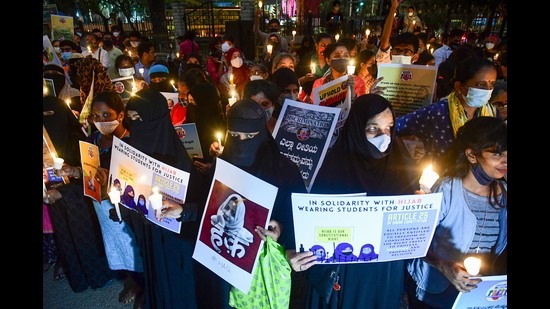Hijab row: Restriction on clothing is political
Even if someone finds a garment distasteful, they have no business either disrobing or advocating the disrobing of its wearer, as long as the wearer asserts her right to wear it
Across the world, stripping and parading (before lynching) has been aimed at punishing not only “errant” individuals, but also to “teach a lesson” and humiliate the group they belong to. In 1989, India passed the Scheduled Caste (SC) and the Scheduled Tribe (ST) (Prevention of Atrocities) Act. Under this law, if a non-SC or ST person “forcibly removes clothes from the person” of a Dalit or Adivasi person, “parades him naked”, or “commits any similar act, which is derogatory to human dignity”, he will be penalised. This same law protects SC or ST women from assaults “with intent to dishonour or outrage her modesty.”

Muslim women have no such special protection and feminists are not enamoured of the term “modesty”. However, in 2007, the Supreme Court (SC) defined “modesty” in Section 354 of the Indian Penal Code to include many forms of coercion, including “removing her saree”. The decisive factors in determining culpability, the SC said, were to be the “intention of the accused” and “the reaction of the woman”. Many experts said this reflected the increased sensitivity in law to the sexual dignity of women. Indeed, defined thus, outraging the modesty of women, by words, sounds, gestures, and exhibiting objects with sexual connotations, can be used to protect the sexual autonomy of women in spaces not falling within the ambit of harassment at the workplace.
The problemitisation of the terms “honour” and “virtue” is an important contribution of feminists, pointing out how these concepts have been used to snatch away the sexual autonomy of women. But when it comes to garments, liberal feminists have confused sexual autonomy as being inherently present in or absent from particular garments. This leads them to fixate against one garment and miss out that all clothing is about the contextual politics of covering, or nakedness, which has been deployed historically to humiliate communities.
Add to this confusion that no matter which Muslim practice happens to be in the eye of an engineered storm of controversy, they are deemed undeserving of sympathy. Muslims are lectured to as recalcitrant pupils who refuse to learn to be progressive or be reasonable. Ergo, “they need to be taught a lesson”, and disrobing is a classic punishment. The Right-wing seeks to teach them a different lesson and liberal progressives another, but ultimately, their knee-jerk anti-hijab stance unites them again in blaming the victim.
Clearly, restriction on clothing is political. Clothes can also express resistance to forms of oppression. Those who are extolling the virtues of uniforms might consider that uniforms can be tools of control too and students in colleges do experience not having to wear uniforms as freedom.
The current debate around the hijab is a critical moment showing generational shifts in feminist understanding of issues thrown up by time and context. For example, the debate around the caste privilege of upper-caste feminists. The hijab debate, therefore, must include a renewed discussion on civil liberties and cultural rights. Otherwise, what it would take for the idea that Muslim women have a flawed understanding of issues and no agency to be thrown into dustbins of feminist thought?
Many women find sari to be an inconvenient garment. Those who have the autonomy to dress for convenience wear saris only on ceremonial occasions. However, many women wear saris 24x7 as a garment appropriate to their cultural milieu. Does that qualify as indoctrination? Many women find burqa a dress of convenience, which helps them hide poverty with dignity. Others adorn expensive and accessorised abayas as a personal fashion statement. On the other hand, many non-hijabi women assert the ideas of dressing modestly. And yes, many do feel forced to wear it. A salwar is accepted by conservatives in most of India. Only less than half a century ago, it was radical for a married woman in Uttar Pradesh to wear the “Punjabi suit”. All garments acquire contextual meaning. No garment has an eternally fixed inherent meaning.
The insistence of cultural elites — who claim to speak for Muslims — on the old framing of Muslim women’s garments, is a kind of orthodoxy, not a higher moral ground. Even as someone finds a garment distasteful, they have no business either disrobing or advocating the disrobing of its wearer, as long as the wearer asserts her right to wear it.
Ghazala Jamil is assistant professor, Centre for the Study of Law and Governance, Jawaharlal Nehru University The views expressed are personal
Continue reading with HT Premium Subscription




